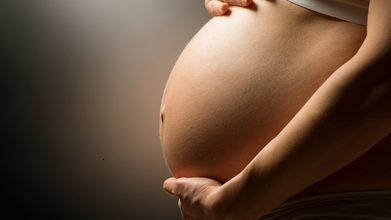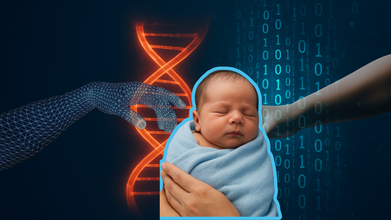- Health Conditions A-Z
- Health & Wellness
- Nutrition
- Fitness
- Health News
- Ayurveda
- Videos
- Medicine A-Z
- Parenting
Does Breastmilk Change When Your Baby Is Sick?

Credits: Canva
Breastmilk is one of the best ways to boost your child's immune system and prevent them from getting sick. Well, it does not mean that your baby will never catch a virus, but breast milk could actually help your baby fight it off.
Breastmilk changes as per your baby's needs. Even when your baby is not fighting a virus, milk has a number of elements that help protect your baby from illness and infections. Breastmilk, to start with is full of antibodies, especially highest in colostrum. While the highest levels stay when your baby receives the milk right after birth and a few days afterwards, the antibodies remain present the whole time you nurse your baby.
Breastmilk also contains a blend of proteins, fats, sugars, and white blood cells. Furthermore it includes lactoferrin, lactadherin, antiproteases, and osteopontin, these are antivirals and anti-inflammatories that help you baby build a strong immune system.
As per the Academy of Breastfeeding Medicine (ABM), the breast milk changes when the mother is sick too.
How does breastmilk change?
As per a 2012 study published in Pediatric Research, titled Changes in immunomodulatory constituents of human milk in response to active infection in the nursing infant, when a baby has an active infection, the white blood cell content (macrophages) of mother's breast milk increases, as do other protective factors.
While another 2013 study titled Maternal and infant infections stimulate a rapid leukocyte response in breastmilk, looked at the baseline amounts of leukocytes, which is a type of white blood cells in breast milk during times of illness for the nursing mother or their nursed baby. The study found that leukocytes increased significantly, whenever the mother or the child was sick.
Researchers believe that this happens due to a process called "baby spit backwash". During breastfeeding, the suckling motion creates a vaccum-like pressure which makes the mixture of breast milk and baby saliva go back up in mother's body. This signals the mother's body to produce more immune cells as per the baby's need. This process allows mother's body to sense baby's health through baby's saliva and changes the composition of her breast milk to best suit child's health.
Does breastmilk change if your baby has COVID-19?
As per the World Health Organization (WHO) and a 2021 study published in the International Breastfeeding Journal, it is safe to breastfeed, if you have COVID-19. In fact, WHO recommends that lactating parents with COVID-19 can continue to nurse their infants.
The 2021 study also suggests that babies who were nursed were less likely to test positive for COVID-19 than babies who did not receive any breast milk. Furthermore, antibodies for COVID-19 was found in breast milk of parents who have COVID-19 and parents who have received vaccination against COVID-19.
This indicates that breastfed baby can build immunity against COVID-19 even without getting sick or vaccinated themselves. It is important to note that there is no evidence that the SARS-CoV-2 virus can be passed to a baby via breastmilk.
How To Manage Diabetes During Pregnancy? Here's What WHO's Guidelines Say

Credits: Canva
The World Health Organization (WHO) has released its first global guidelines dedicated specifically to the management of diabetes during pregnancy, a major milestone for maternal and newborn health. Diabetes affects one in six pregnancies worldwide, impacting nearly 21 million women every year, and the newly released recommendations aim to transform how this growing health challenge is recognized, treated, and prevented across all health systems.
Why Diabetes in Pregnancy Demands Urgent Attention
Diabetes during pregnancy, whether pre-existing or gestational, can be dangerous if not properly managed. Poor blood sugar control significantly raises the risk of pre-eclampsia, stillbirth, obstructed labor, birth injuries, and other complications. The long-term consequences are equally serious: both mothers and babies face a higher lifetime risk of type 2 diabetes, heart disease, and other cardiometabolic disorders.
The impact is especially severe in low- and middle-income countries, where women often lack access to early screening, essential medicines, glucose testing supplies, and specialized care. These guidelines are intended to close those gaps and ensure that women everywhere receive timely, high-quality support.
A Historic Step for Maternal Health
While WHO has previously offered guidance on general diabetes management and separate recommendations for pregnancy, this is the first time a specific, unified standard of care has been created for diabetes during pregnancy.
“These guidelines are grounded in the realities of women's lives and health needs, and provide clear, evidence-based strategies to deliver high-quality care for every woman, everywhere,” said Dr. Tedros Adhanom Ghebreyesus, WHO Director-General.
The guidelines outline 27 key recommendations, covering the full spectrum of prevention, screening, and treatment.
What the New Guidelines Recommend
Individualized Care Plans
The WHO stresses the need for personalized, culturally appropriate guidance on:
- Diet and nutrition
- Physical activity
- Blood sugar targets based on health status and gestational age
By tailoring these recommendations, healthcare providers can better support women in managing day-to-day glucose levels throughout pregnancy.
Optimal Glucose Monitoring
Regular and accurate monitoring is central to safe pregnancy care. The guidelines recommend:
- Frequent blood glucose testing during clinic visits
- Home monitoring using glucometers or continuous glucose sensors where possible
- Early detection of abnormal levels helps prevent complications.
Personalized Medication Strategies
Treatment must differ for type 1 diabetes, type 2 diabetes, and gestational diabetes. When lifestyle changes alone are not enough, the guidelines outline clear medication pathways for insulin and other pharmacologic options.
Multidisciplinary Support for High-Risk Women
Women with pre-existing diabetes should receive coordinated care involving obstetricians, endocrinologists, nutritionists, and diabetes educators to reduce risks throughout pregnancy and childbirth.
A Turning Point for Maternal and Newborn Health
Launched on World Diabetes Day 2025, the guidelines align with this year’s theme, “Diabetes Across Life Stages,” which highlights the need for lifelong diabetes awareness, prevention, and care. The campaign emphasizes that every person, child, adolescent, adult, or older adult, deserves access to integrated services that preserve dignity, health, and long-term well-being.
Diabetes remains one of the world’s fastest-growing health threats, currently affecting over 800 million people. It is a leading cause of heart disease, kidney failure, blindness, and limb amputation. Its rise has been steepest in resource-limited regions, where access to screening and essential medicines is often inadequate.
A Call for Global Action
By centering diabetes management across all life stages, WHO’s new guidelines highlight the urgent need for health systems to expand antenatal care, improve access to diagnostic tools, and ensure equitable availability of essential medicines. Strengthening diabetes care during pregnancy is not only lifesaving—it protects future generations and helps build healthier societies worldwide.
A Baby Made by AI? The Groundbreaking Birth That’s Rewriting Reproductive Science

Credits: Canva
Many breakthroughs in medicine, and now there is also a baby conceived without a womb, but from an artificial intelligence based fertilization (IVF) system.
This happened in Guadalajara, Mexico, where a 40-year-old woman gave birth to the world's first baby conceived through an AI-assisted IVF process. The groundbreaking event was made possible by a sperm-injecting robot, which was remotely operated by fertility specialists based in New York.
How the Technology Works
The innovation was made possible by the process called Intracytoplasmic Sperm Injection (ICSI), a method where a single sperm is injected directly into an egg under a microscope.
Traditionally, this delicate task requires the steady hands and precision of highly skilled embryologists. However, even the most experienced professionals face limitations in accuracy and consistency.
That’s where AI comes in. The AI-powered robot, developed by the New York-based biotech firm Conceivable Life Sciences, follows 23 precise programmed steps: from sperm selection to injection, with remarkable accuracy. In this experiment, five eggs were fertilized, four developed into embryos, and on the second transfer attempt, the world’s first AI-assisted baby was born.
Why Is It A Turning Point?
IVF has long been a mix of science and art, heavily dependent on human judgment and precision. Success rates vary widely depending on expertise and timing. But with automation, the process can become standardized and more predictable, reducing the room for error.
Experts suggest that AI can not only perform fertilization but also learn from each cycle. Its algorithms can analyze which sperm are healthiest, which embryos are most viable, and which steps produce the best outcomes. In essence, it acts like a tireless embryologist, one that doesn’t fatigue or make emotional decisions.
A More Accessible Future for IVF
AI-assisted technology could also help make fertility treatments more affordable and accessible. In India, IVF costs range between ₹1.5 lakh to ₹3 lakh per cycle, and many couples require multiple attempts. By automating intricate steps, clinics could eventually lower costs and reduce waiting times.
According to reproductive endocrinology experts, automation will allow fertility centers to scale up care, reaching people who currently lack access to advanced reproductive services. Conceivable Life Sciences co-founder Alejandro Chavez-Badiola envisions a future where every IVF lab is equipped with a robotic assistant working alongside human specialists, ensuring precision, consistency, and faster results.
Restoring Hope for Millions
Infertility affects over 48 million couples worldwide, often leading to deep emotional and financial distress. Each failed IVF attempt can feel devastating. The AI-IVF breakthrough offers a new ray of hope, potentially improving success rates by minimizing embryo damage and accurately identifying the most viable ones. For many couples, this could mean fewer procedures and quicker success.
Ethical and Human Questions
However, the rise of AI in reproduction raises important ethical and accountability questions. Should AI decide which embryo is chosen? Who is responsible if something goes wrong? Would it be the doctor, the programmer, or the machine?
Medical experts agree that while AI can enhance accuracy, human oversight remains essential. The emotional and ethical aspects of creating life cannot be reduced to algorithms. As one expert noted, “AI may handle the how, but humans must still decide the why.”
Catherine Paiz Is Pregnant At 35; What Should Mothers Planning Pregnancy After 30 Know?

Credits: Instagram
Catherine Paiz, is pregnant at 35 and is expecting her fourth baby. This is her first with husband Igon Ten. Paiz shared the news on her Instagram page and wrote that she was "so shocked" to learn the news about her pregnancy.
On her Instagram post, she wrote: "I'm pregnant!!!!! Still so shocked ahhhhh". She also included videos of her taking the pregnancy test, where she could be heard saying, "Last night I peed about five times and I'm curious. I'm confused. I'm exactly one month from the day I got married today. It is the 27th of October."
Also Read: What Is Hormone Replacement Therapy for Menopause? What Will Change Under Recent FDA Guidelines?
Paiz pregnancy at 35 has yet again sparked spotlight on late motherhood trends. In fact, data also shows the same trend.

The Trend Of Late Motherhood
The average age of mothers in the US have continued to rise, a new report released on June 13 by the National Vital Statistic System (NVSS), provides the shift in age trends between 2016 and 2023. The study, conducted by Andrea D. Brown, Ph.D., M.P.H., and her colleagues at the National Center for Health Statistics.
The researchers found a clear increase in the mean age of mothers at the time of their first birth. In 2016, the average age of a first-time mother was 26.6 years. By 2023, this had risen to 27.5 years — nearly a full year’s difference in just seven years.
Also Read: Intermittent Fasting and Brain Health: Is There a Risk of Cognitive Decline?
But the trend isn’t limited to first-time mothers. In Paiz's case, she is having her fourth child at 35.
Is Late Pregnancy Healthy?
The National Institute of Health (NIH), US (2022), 20% of women in the US are now having their first child after the age of 35. While it is the new trend, the NIH doctor Dr Alan Decherney, a fertility expert explains that "As women age, they are still fertile, but their odds of pregnancy are decreased because they are not making as many good eggs that will fertile and divide normally and turn out to be an embryo."
After age 30, a woman's fertility decreases ever year, notes the NIH July 2022 issue. It notes: "The number and quality of her eggs goes down until she reaches menopause."
However, experts do point out that getting pregnant in your 30s need not be a stressful affair at all times. As it is at this age when you experience more stability, and also someone you know who have a personal experience in handling one. Most important, you are more mature at this age, which you may not be in your 20s.
Also Read: Davina McCall Reveals Breast Cancer Surgery A Year After Her Brain Tumor Surgery
What Must You Keep In Mind If You Plan Pregnancy After 30?
Quit Habits: If you are a smoker, or consume alcohol, this is a good time to leave it.
Reduce Stress: While pregnancy for some can bring stress, try to find activities that help you release it.
Healthy Weight: Ensure that your weight is right, reduce your waist to bring it to a healthy range for a healthy pregnancy.
Food Habits: Stop eating junk and start eating more whole grains.
Exercise: A sedentary lifestyle can impact negatively on the child. You do not have to do HIIT, however, regular easy workouts can make both the pregnancy and delivery easy.
Dr Michelle Y Owens, professor of obstetrics and gynecology and a practicing maternal-fetal medicine specialist at the University of Mississippi Medical Center in Jackson, writes for the American College of Obstetricians and Gynecologists (ACOG) that "the longer your eggs have been around, the more likely they are to produce a pregnancy with a chromosome problem that can lead to a condition like Down syndrome. The risk goes up significantly after 35." However, she says, there is a good news. Now, we have tools to detect and respond to pregnancy complications early.
© 2024 Bennett, Coleman & Company Limited

